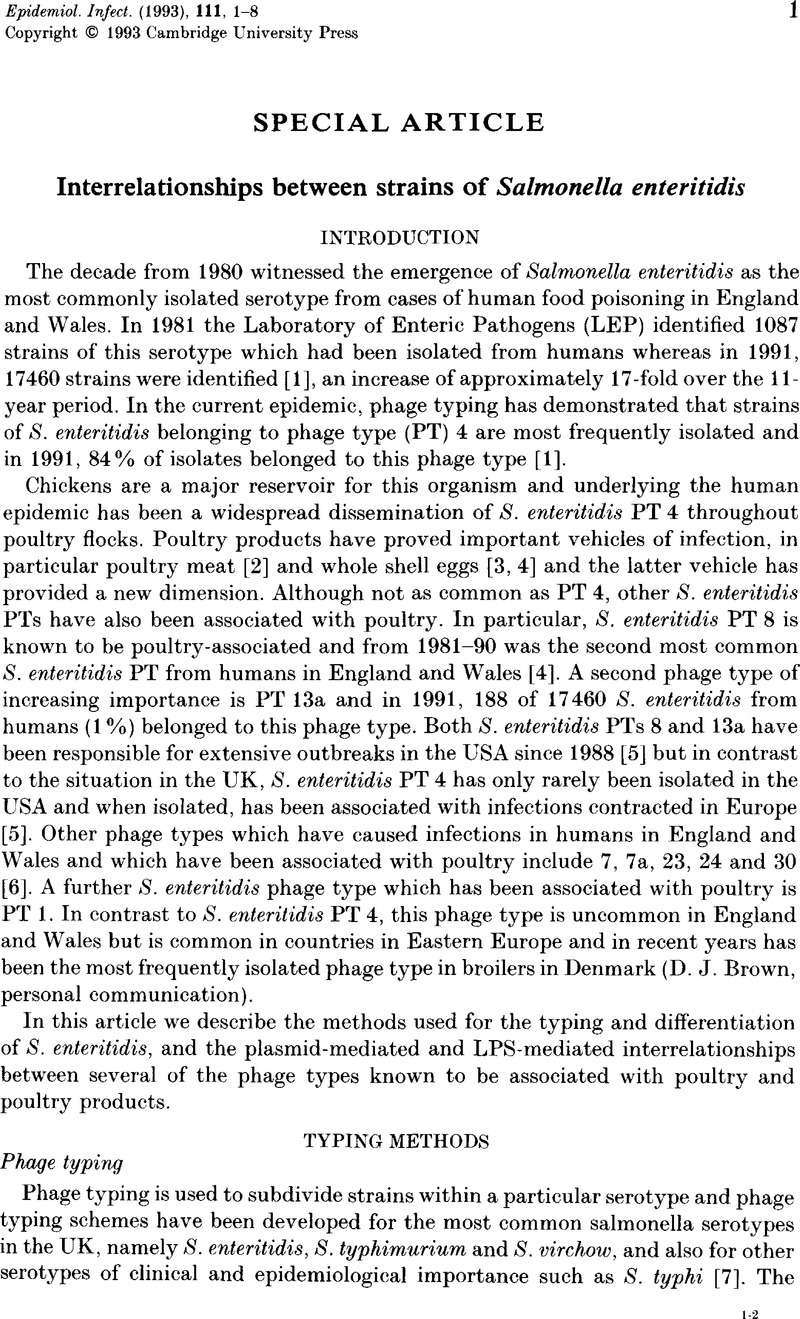Crossref Citations
This article has been cited by the following publications. This list is generated based on data provided by Crossref.
Olsen, J.E.
Brown, D.J.
Skov, M.N.
and
Christensen, J.P.
1993.
Bacterial typing methods suitable for epidemiological analysis. applications in investigations of salmonellosis among livestock.
Veterinary Quarterly,
Vol. 15,
Issue. 4,
p.
125.
Helmuth, R.
and
Schroeter, A.
1994.
Molecular typing methods for S. enteridis.
International Journal of Food Microbiology,
Vol. 21,
Issue. 1-2,
p.
69.
Olsen, John Elmerdahl
and
Skov, Marianne
1994.
Genomic lineage of Salmonella enterica serovar Dublin.
Veterinary Microbiology,
Vol. 40,
Issue. 3-4,
p.
271.
Lax, A.J.
Barrow, P.A.
Jones, P.W.
and
Wallis, T.S.
1995.
Current perspectives in salmonellosis.
British Veterinary Journal,
Vol. 151,
Issue. 4,
p.
351.
Leung, Michael
1995.
Simultaneous infection by a sensitive and a multiresistant strain of Salmonella paratyphi A.
Journal of Infection,
Vol. 30,
Issue. 2,
p.
181.
Irino, K.
Fernandes, S.A.
Tavechio, A.T.
Neves, B.C.
and
Dias, A.M.G.
1996.
Progression of Salmonella Enteritidis phage type 4 strains in São Paulo State, Brazil.
Revista do Instituto de Medicina Tropical de São Paulo,
Vol. 38,
Issue. 3,
p.
193.
Hilton, A.C.
Banks, J.G.
and
Penn, C.W.
1996.
Random amplification of polymorphic DNA (RAPD) of Salmonella: strain differentiation and characterization of amplified sequences.
Journal of Applied Microbiology,
Vol. 81,
Issue. 6,
p.
575.
Sakai, T.
and
Chalermchaikit, T.
1996.
The major sources of Salmonella enteritidis in Thailand.
International Journal of Food Microbiology,
Vol. 31,
Issue. 1-3,
p.
173.
Tavechio, A.T.
Fernandes, S.A.
Neves, B.C.
Dias, A.M.G.
and
Irino, K.
1996.
Changing patterns of Salmonella serovars: increase of Salmonella Enteritidis in São Paulo, Brazil.
Revista do Instituto de Medicina Tropical de São Paulo,
Vol. 38,
Issue. 5,
p.
315.
Hilton, A.C.
Banks, J.G.
and
Penn, C.W.
1996.
Random amplification of polymorphic DNA (RAPD) of Salmonella: strain differentiation and characterization of amplified sequences.
Journal of Applied Bacteriology,
Vol. 81,
Issue. 6,
p.
575.
Nastasi, A.
and
Mammina, C.
1996.
Epidemiology of Salmonella enterica serotype Enteritidis infections in southern Italy during the years 1980–1994.
Research in Microbiology,
Vol. 147,
Issue. 5,
p.
393.
Buchrieser, C.
Brosch, R.
Buchrieser, O.
Kristl, A.
Luchansky, J.B.
and
Kaspar, C.W.
1997.
Genomic Analyses of Salmonella enteritidis Phage Type 4 Strains from Austria and Phage Type 8 Strains from the United States.
Zentralblatt für Bakteriologie,
Vol. 285,
Issue. 3,
p.
379.
Gado, István
Lászlo, Vera G.
Nagy, Béla
Milch, Hedda
Drin, István
Awad-Masalmeh, Mohamed
and
Horváth, Judit
1998.
Phage Restriction and the Presence of Small Plasmids in Salmonella enteritidis.
Zentralblatt für Bakteriologie,
Vol. 287,
Issue. 4,
p.
509.
Skibsted, U.
Baggesen, D.L.
Dessau, R.
and
Lisby, G.
1998.
Random amplification of polymorphic DNA (RAPD), pulsed-field gel electrophoresis (PFGE) and phage-typing in the analysis of a hospital outbreak of Salmonella Enteritidis.
Journal of Hospital Infection,
Vol. 38,
Issue. 3,
p.
207.
Jackson, C. J.
Fox, A. J.
Jones, D. M.
Wareing, D. R. A.
and
Hutchinson, D. N.
1998.
Associations between Heat-Stable (O) and Heat-Labile (HL) Serogroup Antigens of
Campylobacter jejuni
: Evidence for Interstrain Relationships within Three O/HL Serovars
.
Journal of Clinical Microbiology,
Vol. 36,
Issue. 8,
p.
2223.
Murakami, Koichi
Horikawa, Kazumi
and
Otsuki, Koichi
1999.
Epidemiological Analysis of Salmonella enteritidis from Human Outbreaks by Pulsed-Field Gel Electrophoresis..
Journal of Veterinary Medical Science,
Vol. 61,
Issue. 4,
p.
439.
Soto, S. M.
Guerra, B.
González-Hevia, M. A.
and
Mendoza, M. C.
1999.
Potential of Three-Way Randomly Amplified Polymorphic DNA Analysis as a Typing Method for Twelve
Salmonella
Serotypes
.
Applied and Environmental Microbiology,
Vol. 65,
Issue. 11,
p.
4830.
Lukinmaa, Susanna
Schildt, Raili
Rinttilä, Teemu
and
Siitonen, Anja
1999.
Salmonella
Enteritidis Phage Types 1 and 4: Pheno- and Genotypic Epidemiology of Recent Outbreaks in Finland
.
Journal of Clinical Microbiology,
Vol. 37,
Issue. 7,
p.
2176.
Laconcha, Idoia
Baggesen, Dorte Lau
Rementeria, Aitor
and
Garaizar, Javier
2000.
Genotypic characterisation by PFGE of Salmonella enterica serotype Enteritidis phage types 1, 4, 6, and 8 isolated from animal and human sources in three European countries.
Veterinary Microbiology,
Vol. 75,
Issue. 2,
p.
155.
Aabo, S.
Christensen, J. P.
Chadfield, M. S.
Carstensen, B.
Olsen, J. E.
and
Bisgaard, M.
2002.
Quantitative comparison of intestinal invasion of zoonotic serotypes of Salmonella enterica in poultry.
Avian Pathology,
Vol. 31,
Issue. 1,
p.
41.


